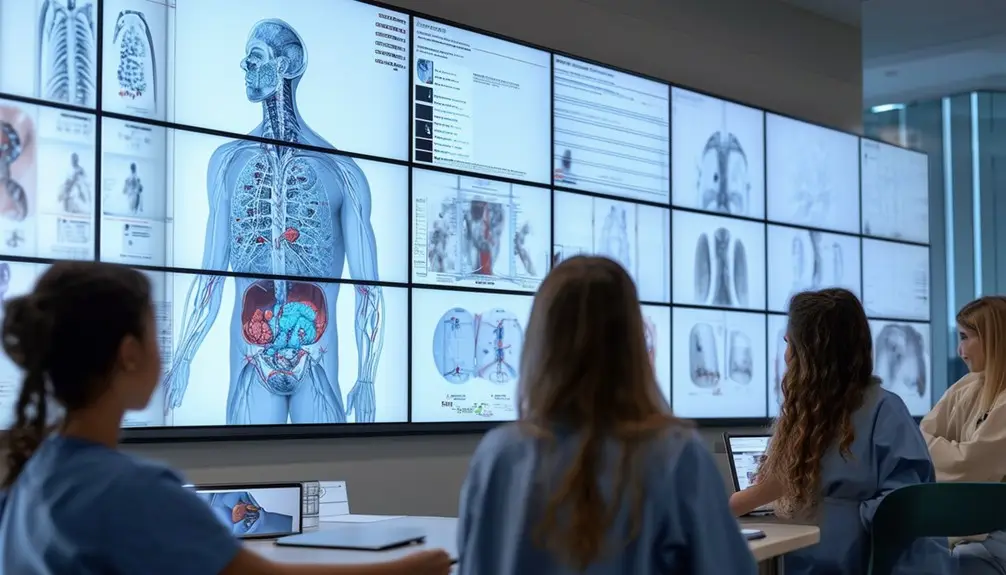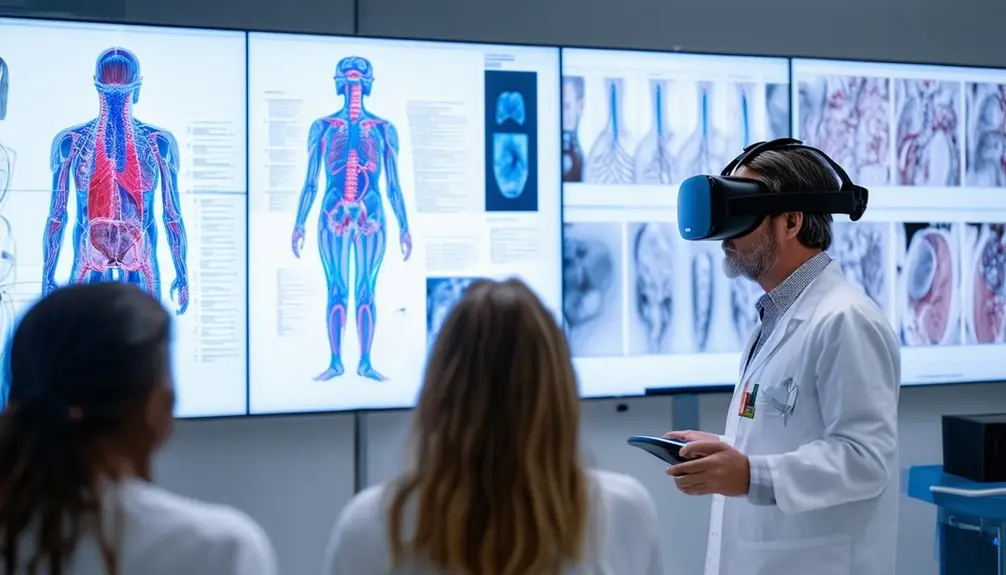You’ll find digital displays a game-changer for medical education by significantly boosting learning retention, engagement, and comprehension. Studies indicate a 60% increase in retention and a 30% rise in comprehension with interactive content. Digital displays provide real-time updates, ensuring you access the latest information. They’re cost-effective, reducing training expenses by 30% and printing costs by 40%. Tailoring content to different learning styles and patient needs enhances understanding and engagement. Digital displays empower you with immersive and personalized educational experiences, paving the way for profound improvements in medical training and patient education. Explore further to reveal more insights.
Table of Contents
ToggleKey Takeaways
- Digital displays boost medical education retention by up to 60% with interactive and engaging content.
- Real-time updates on digital displays ensure medical students access the latest advancements and guidelines.
- Visual aids and simulations on digital displays enhance comprehension of complex medical procedures.
- Personalized learning paths on digital displays cater to individual needs, improving educational outcomes.
- Cost-effective digital displays reduce training expenses and printing costs while providing high-quality, up-to-date educational materials.
Benefits of Digital Displays

Digital displays in medical education greatly improve learning retention and student engagement. Studies show that these digital tools can boost learning retention by up to 60% compared to traditional methods. This notable improvement is largely due to the use of interactive content, which makes lectures more engaging. When students interact with digital displays, they’re more likely to participate actively, leading to better comprehension and knowledge retention.
Medical schools adopting digital displays report a 30% increase in student comprehension. This improvement isn’t just anecdotal; it’s supported by data. The interactive nature of digital content encourages students to engage more deeply with the material, fostering a more dynamic and participatory learning environment. This heightened engagement directly translates into better learning outcomes.
Digital displays provide real-time updates and dynamic content, ensuring that students have access to the most current medical information. This feature is vital in a field where knowledge is constantly evolving. Additionally, digital displays offer a cost-effective solution for medical schools, allowing them to deliver high-quality, interactive, and visually engaging educational content without breaking the bank. By incorporating digital displays into your medical education curriculum, you can significantly improve both student engagement and learning retention.
Enhancing Medical Training

You can enhance your medical training with interactive digital modules that offer hands-on experience with complex procedures. These tools provide real-time updates on the latest medical advancements, ensuring you’re always learning the most current techniques. By incorporating visual aids and simulations, digital displays markedly improve knowledge retention and application.
Interactive Training Modules
Interactive training modules revolutionize medical education by enhancing engagement and retention of critical information. These modules leverage technology to create immersive learning experiences that actively involve learners. By incorporating gamification elements, you can boost learner participation and ensure that knowledge is retained more effectively. These modules offer real-time feedback and assessments, enabling you to track your progress and identify areas for improvement immediately.
An essential feature of interactive training modules is their ability to create personalized learning paths. This customization tailors the educational content to your specific needs, accommodating diverse learning styles and paces. Medical simulations within these modules provide hands-on experience in a controlled, risk-free environment, preparing you for real-life clinical situations.
- Gamification Elements: Enhance engagement and improve knowledge retention.
- Real-Time Feedback: Allow for effective progress tracking and immediate improvement.
- Personalized Learning Paths: Cater to individual needs and learning styles.
Utilizing interactive training modules, you’ll find that your medical education becomes more dynamic and effective. These evidence-based tools are not just about transferring knowledge but also about making sure that you are actively involved in your learning journey, leading to better outcomes and a deeper understanding of medical concepts.
Real-Time Medical Updates
Real-time medical updates on digital displays greatly enhance medical training by guaranteeing healthcare professionals have immediate access to the latest advancements and best practices. With these digital displays, you can stay current with evolving treatments, procedures, and protocols. They provide instant access to updated medical guidelines, research findings, and best practices, fostering continuous learning.
Digital displays make medical education content readily available, which is essential for effective medical training. By integrating real-time updates, you make sure that your knowledge base is always up-to-date. This approach not only keeps you informed but also equips you to deliver high-quality care.
Incorporating digital displays into medical education content supports a culture of lifelong learning among healthcare professionals. As you engage with real-time updates, you can quickly adapt to new information, improving your decision-making and clinical skills.
Real-Time Information Sharing
Leveraging digital displays in healthcare facilities revolutionizes patient education by instantly providing the most current medical content. With real-time information sharing, you can make sure that patients receive the latest updates on their health conditions and treatment options. These displays allow you to share critical health information efficiently, enhancing the overall healthcare experience.
Digital displays in healthcare facilities offer numerous benefits:
- Instant Educational Videos: You can broadcast educational videos that cover a wide range of medical topics, helping patients understand their diagnoses and treatments better.
- Up-to-Date Announcements: Important announcements and news can be disseminated instantly, ensuring everyone stays informed about any changes in hospital policies or procedures.
- Disease Prevention Tips: By sharing real-time information on disease prevention, you can actively engage patients in maintaining their health and preventing illnesses.
Real-time information sharing not only improves patient education but also facilitates better communication between medical staff, patients, and visitors. By providing immediate access to critical health information, you can help patients make informed decisions about their care. This approach not only enhances patient engagement but also leads to more efficient healthcare delivery, ultimately improving patient outcomes.
Customizable Content Options
In addition to real-time updates, offering customizable content options empowers healthcare facilities to tailor educational materials to meet the specific needs of their patients. By integrating customizable educational content, you can provide interactive quizzes, videos, infographics, and patient testimonials that resonate with diverse patient demographics and medical specialties. This approach guarantees that the medical information disseminated is both relevant and engaging.
Customizable content enhances patient and healthcare professional engagement, leading to better retention of critical medical information. Whether you’re focusing on specific procedures or general health practices, personalized educational content can be updated regularly to reflect the latest advancements and best practices in healthcare.
Here’s a visual representation of customizable content options:
| Customizable Content | Benefits |
|---|---|
| Interactive Quizzes | Enhances engagement and retention |
| Videos | Caters to visual learners |
| Infographics | Simplifies complex medical information |
| Patient Testimonials | Builds trust and relatability |
| Regular Updates | Secures current and accurate content |
This dynamic approach to delivering educational content caters to various learning styles and preferences, effectively enhancing the medical education experience. By implementing customizable content, you’re not just informing; you’re transforming the way medical knowledge is shared and absorbed.
Improving Patient Education

By utilizing digital displays, healthcare facilities can greatly enhance patient education and comprehension. Research indicates that patients retain 80% more information when engaging with digital education compared to traditional methods. This retention boost is essential for understanding complex medical conditions and treatment options.
Digital displays offer healthcare providers an effective means to deliver interactive content that actively engages patients. This engagement leads to higher satisfaction rates and improved health outcomes. Here are three key benefits of using digital displays for patient education:
- Visual Aids: Digital displays can illustrate medical conditions and procedures with clarity, making it easier for patients to grasp intricate details.
- Customized Content: Tailoring educational materials to fit various patient demographics and learning styles ensures that everyone receives information in an accessible manner.
- Enhanced Retention: Interactive content on digital displays aids memory retention, ensuring patients remember essential information about their health.
With these advantages, healthcare facilities can transform how they educate patients, making the process more effective and personalized. By embracing digital displays, you’re not just imparting knowledge but also empowering patients to take control of their health with confidence and clarity.
Interactive Learning Tools

Interactive learning tools on digital displays don’t just engage medical students; they also enhance patient education, boost staff training, and provide real-time information updates. These tools offer simulations, quizzes, and virtual patient cases, which improve knowledge retention and clinical decision-making skills. By catering to different learning styles, you can guarantee a more personalized and effective educational experience.
Enhancing Patient Education
Using interactive learning tools on digital screens greatly enhances patient engagement and retention of essential medical information. When patients interact with digital displays, they’re more likely to understand and remember the content presented. This method of patient education is particularly effective because it engages multiple senses, offering a richer learning experience.
Studies indicate that interactive learning tools can significantly improve patient knowledge about their health conditions. This increased understanding translates to better adherence to medical advice and treatment plans. Additionally, medical facilities employing these tools report higher patient satisfaction and improved health outcomes.
Consider these benefits of using interactive digital displays:
- Improved Retention: Patients are more likely to recall medical information when it’s presented interactively.
- Empowerment: Interactive tools empower patients to take an active role in managing their health.
- Satisfaction: Enhanced education leads to higher patient satisfaction and better health outcomes.
Boosting Staff Training
Digital displays featuring interactive learning tools can revolutionize staff training in healthcare settings. By incorporating elements like quizzes, videos, and simulations, these digital tools greatly enhance engagement and retention. Studies indicate that interactive learning tools can increase knowledge retention by up to 60% compared to traditional methods. This makes them invaluable for guaranteeing that healthcare professionals are well-prepared and competent.
Interactive learning tools also offer real-time feedback, which is essential for effective staff training. When you receive immediate feedback, you can quickly correct mistakes and reinforce correct practices. Additionally, these tools provide personalized learning experiences, allowing you to focus on areas where you need the most improvement. This level of customization ensures that training programs can be tailored to meet the specific needs and roles of different staff members.
The customizable content available on digital displays allows for highly adaptable training modules. You can update or modify training materials effortlessly to keep up with the latest healthcare guidelines and protocols. By leveraging these advanced tools, you can guarantee that staff training is not only more engaging but also more effective and aligned with current medical standards.
Real-Time Information Updates
In addition to enhancing staff training, real-time information updates on digital displays offer interactive learning tools that keep both students and healthcare professionals engaged with the latest medical advancements. These tools transform static learning into dynamic experiences, which is essential for understanding complex medical procedures and evolving treatment methods.
With real-time updates, you can access the latest medical research, case studies, and best practices instantly. This immediacy supports educational purposes by ensuring that the content is always current and relevant. For example, you can interact with updates on breakthroughs in clinical trials and advancements in healthcare technology, facilitating a deeper understanding of emerging trends.
Interactive learning tools on digital displays enhance several key aspects of medical education:
- Knowledge Retention: Engaging with real-time data aids in better memory retention and understanding.
- Critical Thinking Skills: Analyzing and interpreting up-to-date information fosters critical thinking and problem-solving abilities.
- Hands-On Learning: Simulated experiences and practical applications of medical procedures become more effective through interactive content.
Cost-Effective Solutions

Harnessing cost-efficient digital displays can reduce training expenses by up to 30% while enhancing the learning experience for medical students to a great extent. By integrating digital displays into medical education, you can significantly decrease training costs. These economical solutions not only lessen the financial burden but also improve information retention by 23%. Digital displays provide an engaging way to present complex medical information, making it easier for students to grasp and remember essential concepts.
The use of digital displays offers a 40% reduction in printing costs for educational materials. Instead of spending on physical textbooks and handouts, you can leverage digital content that is easily updatable and accessible. This shift also supports a more sustainable approach to education.
Interactive digital content delivered through these displays can improve engagement rates by 50%. This increased engagement is vital for effective learning, as students are more likely to participate and absorb information. Additionally, digital solutions can decrease training time for healthcare professionals by 25%, making the learning process more efficient. By adopting these cost-efficient digital displays, you’re not just saving money but also enhancing the overall educational experience for medical students.
Case Studies and Testimonials
Seeing the financial and educational benefits of digital displays, let’s explore real-world examples and testimonials that underscore their effectiveness in medical education. Case studies reveal impressive outcomes, such as a 20% increase in colon cancer screenings and a 28% rise in flu vaccinations when leveraging digital health content. These statistics highlight how digital displays can substantially enhance patient education and engagement.
Real-life examples demonstrate how digital signage improves patient experiences during exams. For instance, digital displays in exam rooms facilitate better interactions with online resources, helping patients understand their conditions and treatment options more thoroughly. Testimonials frequently emphasize the importance of patient control over waiting room content, noting that it positively influences patient engagement and satisfaction.
Partnering with PatientPoint for patient engagement has yielded notable successes:
- Increased Screenings: Notable boosts in colon cancer screenings and flu vaccinations.
- Enhanced Education: Improved patient understanding and interaction with digital health content.
- Patient Satisfaction: Greater patient control over displayed content, leading to enriched patient experiences.
These cases and testimonials make it clear that digital displays aren’t just a cost-effective solution; they’re a transformative tool in medical education, fostering better patient outcomes through enhanced engagement and education.
Implementation Strategies
When implementing digital displays for medical education, you should focus on strategies that capitalize on interactive and multimedia features to maximize engagement and knowledge retention. Start by integrating interactive features such as quizzes and real-time updates. These elements can notably improve learning outcomes, as they actively involve students in the educational process, making them more likely to retain information. Studies indicate that using digital displays can increase information retention by up to 60% compared to traditional methods.
Utilize multimedia content like videos and animations to clarify complex medical concepts and procedures. These visual aids can break down intricate topics, making them easier to understand. For example, animated sequences can demonstrate surgical techniques or physiological processes more efficiently than static images or text alone.
Additionally, digital displays allow for personalized learning experiences, catering to different learning styles. By offering a variety of content formats—text, video, interactive modules—you can address the diverse needs of medical students and professionals. Personalized learning paths can be created, enabling users to focus on areas where they need the most improvement.
Future Trends in Digital Displays
You’ll find future trends in digital displays for medical education promising, especially with AI-driven content personalization and interactive learning technologies. AI-powered displays can provide real-time feedback and tailor educational content to individual needs, enhancing learning outcomes. Additionally, the integration of VR and AR will notably increase student engagement and understanding.
Interactive Learning Technologies
In the future of medical education, interactive learning technologies like VR and AR will transform how you engage with complex medical concepts and procedures. These technologies offer immersive learning experiences that bring textbook scenarios to life, allowing you to explore 3D models and participate in interactive simulations. By simulating real-world medical situations, you can practice and refine your skills in a controlled, risk-free environment.
Digital displays in medical education are designed to adapt to your individual learning needs. Tailored learning paths guarantee that you progress at your own pace, while adaptive assessments provide instant feedback, helping you identify areas that need improvement. This customization enhances your learning efficiency and retention.
Key features of interactive learning technologies include:
- Immersive Learning Experiences: VR and AR allow you to delve into detailed anatomical models and surgical simulations.
- Interactive Simulations: Engage in hands-on practice with virtual patients, improving diagnostic and procedural skills.
- Personalized Learning Paths and Adaptive Assessments: Customize your educational journey with content and assessments that adjust to your performance and learning style.
AI-driven Content Personalization
AI-driven content personalization leverages sophisticated algorithms to tailor medical education materials to your unique learning style, enhancing both engagement and retention. By analyzing your interactions with educational material, AI can deliver targeted medical education content that aligns with how you learn best. This isn’t just about making learning more enjoyable; it’s about making it more effective.
Future trends indicate a growing reliance on AI-driven content personalization in digital displays. As the technology advances, algorithms become more adept at discerning individual learning styles, ensuring that the educational content you encounter is both relevant and impactful. This level of personalization boosts learner engagement, making it easier for you to stay focused and absorb complex medical information.
The benefits are clear: personalized content leads to better information retention and improved educational outcomes. Whether you’re a medical student or a practicing professional, AI-driven content personalization can adapt the learning experience to fit your needs. This revolution in how medical education content is delivered and consumed means that you’re more likely to retain vital knowledge, ultimately enhancing your skills and expertise in the medical field.
Conclusion
You’ve seen how digital displays transform medical education, making it more interactive and effective. They allow real-time information sharing, customizable content, and improved patient education, all while being cost-effective. Case studies and testimonials back these benefits, showcasing successful implementations. Looking ahead, digital displays will continue to evolve, offering even more innovative training solutions. So, don’t get left in the dust—embrace these cutting-edge tools to enhance your medical training programs.
Frequently Asked Questions
What Is Healthcare Digital Signage?
Healthcare digital signage is a technology that uses LED and LCD displays to relay essential information in medical settings. You’ll find it enhances patient education, boosts staff communication, cuts printing costs, and complies with healthcare regulations.
What Does Patient Point Do?
PatientPoint provides digital signage solutions for healthcare facilities, delivering interactive patient education content. Their services boost patient engagement and satisfaction, helping healthcare providers enhance the patient experience and improve health outcomes through informative visual displays.





